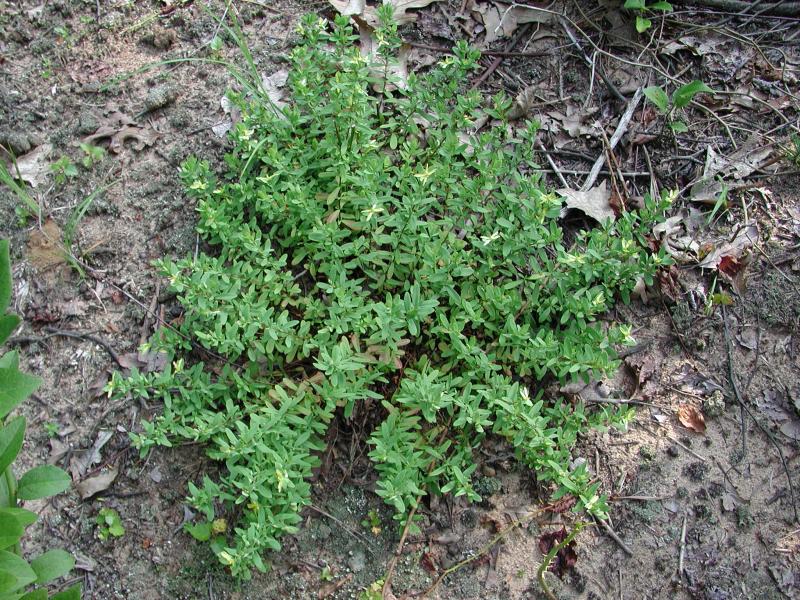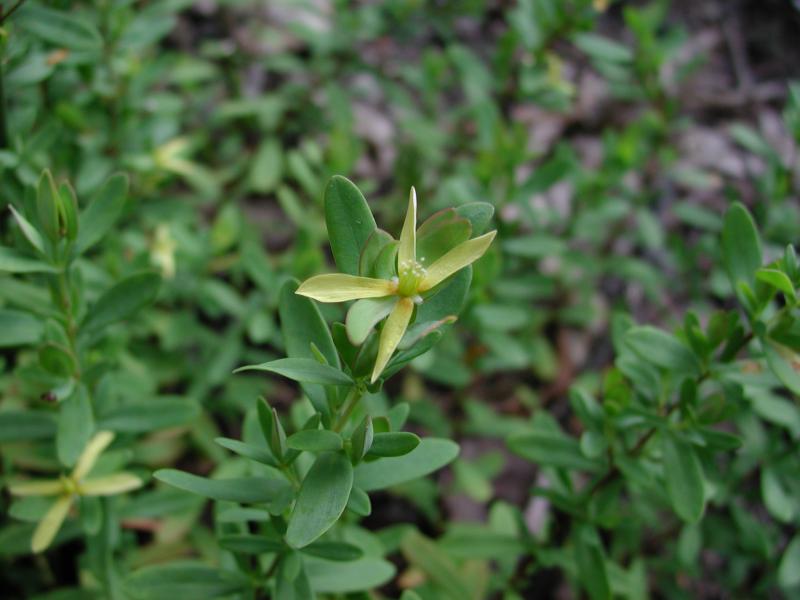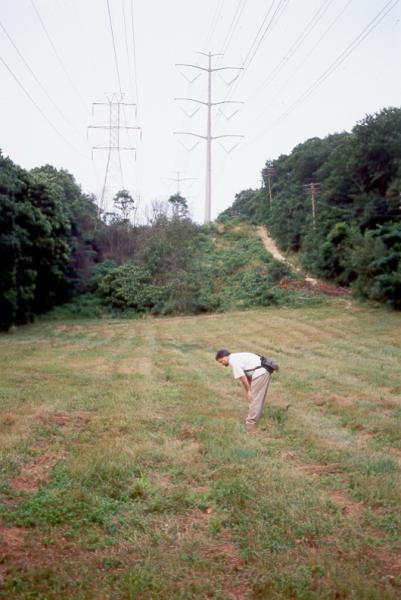Low St. John's Wort
Hypericum stragulum P. Adams & Robson
- Class
- Dicotyledoneae (Dicots)
- Family
- Hypericaceae
- State Protection
- Endangered
Listed as Endangered by New York State: in imminent danger of extirpation in New York. For animals, taking, importation, transportation, or possession is prohibited, except under license or permit. For plants, removal or damage without the consent of the landowner is prohibited.
- Federal Protection
- Not Listed
- State Conservation Status Rank
- S1
Critically Imperiled in New York - Especially vulnerable to disappearing from New York due to extreme rarity or other factors; typically 5 or fewer populations or locations in New York, very few individuals, very restricted range, very few remaining acres (or miles of stream), and/or very steep declines.
- Global Conservation Status Rank
- G5T4
Apparently Secure globally - The subspecies/variety is uncommon in the world but not rare; usually widespread, but may be rare in some parts of its range; possibly some cause for long-term concern due to declines or other factors. (The species as a whole is common globally.)
Summary
Did you know?
This species has managed to take advantage of disturbance created by humans along sandy powerline rights-of-way. The genus name is from the ancient Greek name for this plant, hypericon and is often found in older texts under the genus Ascyron (Fernald 1950).
State Ranking Justification
There are six existing populations but only two of them have over 100 plants. The other four are small in number and area. There are six populations from the late 1800s and early 1900s. Three of them have not been rechecked and three of them are considered extirpated because of development.
Short-term Trends
The short-term trend of most populations is stable or slightly decreasing.
Long-term Trends
Populations have been destroyed on western Long Island and New York City but new populations have been found on eastern Long Island.
Conservation and Management
Threats
The largest threat to these populations is the lack of disturbance and the displacement of plants by succession.
Conservation Strategies and Management Practices
This species needs disturbance to reduce competition from woody plants and more aggressive herbaceous plants. However, too much direct disturbance to the plants will reduce or eliminate the population. Its habitat could be disturbed in the non-growing season to open it up for seed germination and colonization but direct disturbance should be prevented during the growing season.
Research Needs
Research is needed to find out how plants can be augmented in the areas where they occur.
Habitat
Habitat
In New York, this species occurs along a rutted road through pine barrens; partly shrubby, partly rough mown section of powerlines; in open oak wooded hills & in rough mown field; grassy openings around old farm yard in woods mostly of black and white oak; dry, open, oak woods on eroded bank between footpath on canyon rim and steep shale cliffs (New York Natural Heritage Program 2012). Dry sand and rock (Fernald 1970). Dry or rocky soil (Gleason 1952). Dry, rocky slopes and moist rich woods (Gleason & Cronquist 1991).
Associated Ecological Communities
- Coastal oak-beech forest
(guide)
A hardwood forest with oaks and American beech codominant that occurs in dry well-drained, loamy sand of morainal coves of the Atlantic Coastal Plain. Some occurrences are associated with maritime beech forest.
- Coastal oak-heath forest
(guide)
A low diversity, large patch to matrix, hardwood forest that typically occurs on dry, well-drained, sandy soils of glacial outwash plains or moraines of the Atlantic Coastal Plain. The forest is usually codominated by two or more species of scarlet oak, white oak, and black oak.
- Coastal oak-hickory forest
(guide)
A hardwood forest with oaks and hickories codominant that occurs in dry, well-drained, loamy sand of knolls, upper slopes, or south-facing slopes of glacial moraines of the Atlantic Coastal Plain.
- Pitch pine-oak forest
(guide)
A mixed forest that typically occurs on well-drained, sandy soils of glacial outwash plains or moraines; it also occurs on thin, rocky soils of ridgetops. The dominant trees are pitch pine mixed with one or more of the following oaks: scarlet oak, white oak, red oak, or black oak.
Associated Species
- Aira
- Carex pensylvanica (Pennsylvania sedge)
- Deschampsia
- Desmodium
- Krigia virginica (Virginia dwarf-dandelion)
- Lespedeza
- Linum medium
- Lysimachia quadrifolia (whorled-loosestrife)
- Pinus resinosa (red pine)
- Pinus rigida (pitch pine)
- Quercus alba (white oak)
- Quercus montana (chestnut oak)
- Quercus velutina (black oak)
- Schizachyrium scoparium
Range
New York State Distribution
This small shrub is currently known from Staten Island, and Nassau and Suffolk counties on Long Island.
Global Distribution
This low shrub extends from southern New Jersey, west to southern Missouri, and eastern Oklahoma, south to eastern Texas and Florida. It is rare in Pennsylvania and New York where it reaches its northeastern limits.
Identification Comments
General Description
St. Andrew's Cross is a low prostrate shrub forming small mounds of branches and leaves only 1-3 dm high. The opposite, narrowly-elliptic leaves are widest above the middle and 1-3 cm long. The flowers have four yellow, narrow petals that look like a cross or a chromosome. The numerous stamens are short. The one-chambered capsule is topped by two short styles.
Identifying Characteristics
Distinguishing characteristics: decumbent shrub, branched from the base, 10-30 cm tall, forming low, compact mats or mounds, 30-40 cm wide; several prostrate stems; numerous erect slender branches 10-30 cm long; leaves oblong-oblanceolate, 4-9 mm broad; 4 inner sepals minute or obsolete; 4 outer sepals elliptic, oval or oblong-oblanceolate, rounded at base, 5-11 mm long, 3-7 mm broad; 4 light yellow petals, oblong, about equaling the outer sepals, 1.5-4 mm broad; styles 2. Best life stage for ID: in flower. Characteristics needed to ID: prostrate stems with branches, leaves, flowers.
Best Life Stage for Proper Identification
The best time to identify this plant is when it is in flower but it can be identified in leaf because of its prostrate habit and opposite, oblanceolate leaves.
Similar Species
Hypericum hypericoides ssp. hypericoides an erect plant, mostly single-stemmed, freely branched above, (30-)50-120(-150) cm tall, with linear-elliptic to linear-oblong leaves that are broadest near the middle, and sepals and petals that are 10-18 mm long. Hypericum stans is an erect shrub with elliptic-oblong leaves, 7- 15 mm wide, and 3(4) styles.
Best Time to See
This species flowers in late July and August with fruits persisting into late November. It may be distinguished vegetatively most of the growing season.
- Vegetative
- Flowering
- Fruiting
The time of year you would expect to find Low St. John's Wort vegetative, flowering, and fruiting in New York.
Low St. John's Wort Images
Taxonomy
Low St. John's Wort
Hypericum stragulum P. Adams & Robson
- Kingdom Plantae
- Phylum Anthophyta
- Class Dicotyledoneae
(Dicots)
- Order Malpighiales
- Family Hypericaceae
- Order Malpighiales
- Class Dicotyledoneae
(Dicots)
- Phylum Anthophyta
Synonyms
- Ascyrum hypericoides L. [in part.]
- Ascyrum hypericoides var. multicaule (Michx. ex Willd.) Fern.
- Hypericum hypericoides ssp. multicaule (Michx. ex Willd.) Robson
- Hypericum hypericoides var. multicaule (Michx. ex Willd.) Fosberg
- Hypericum multicaule Michx. ex Willd.
- Hypericum stragulum P. Adams & Robson [in part.]
Additional Resources
Best Identification Reference
Crow, Garrett E. and C. Barre Hellquist. 2000. Aquatic and Wetland Plants of Northeastern North America: A revised and enlarged edition of Norman C. Fassett's a Manual of Aquatic Plants. Volume One: Pteridophytes, Gymnosperms, and Angiosperms: Dicotyledons. The University of Wisconsin Press. Madison, Wisconsin. 536 Pages.
Other References
Clemants, Steven and Carol Gracie. 2006. Wildflowers in the Field and Forest. A Field Guide to the Northeastern United States. Oxford University Press, New York, NY. 445 pp.
Fernald, M.L. 1950. Gray's manual of botany. 8th edition. D. Van Nostrand, New York. 1632 pp.
Gleason, Henry A. and A. Cronquist. 1991. Manual of Vascular Plants of Northeastern United States and Adjacent Canada. The New York Botanical Garden, Bronx, New York. 910 pp.
Holmgren, Noel. 1998. The Illustrated Companion to Gleason and Cronquist's Manual. Illustrations of the Vascular Plants of Northeastern United States and Adjacent Canada. The New York Botanical Garden, Bronx, New York.
Mitchell, Richard S. and Gordon C. Tucker. 1997. Revised Checklist of New York State Plants. Contributions to a Flora of New York State. Checklist IV. Bulletin No. 490. New York State Museum. Albany, NY. 400 pp.
New York Natural Heritage Program. 2010. Biotics database. New York Natural Heritage Program. New York State Department of Environmental Conservation. Albany, NY.
New York Natural Heritage Program. 2024. New York Natural Heritage Program Databases. Albany, NY.
Reschke, Carol. 1990. Ecological communities of New York State. New York Natural Heritage Program, New York State Department of Environmental Conservation. Latham, NY. 96 pp. plus xi.
Weldy, T. and D. Werier. 2010. New York flora atlas. [S.M. Landry, K.N. Campbell, and L.D. Mabe (original application development), Florida Center for Community Design and Research http://www.fccdr.usf.edu/. University of South Florida http://www.usf.edu/]. New York Flora Association http://newyork.plantatlas.usf.edu/, Albany, New York
Zaremba, Robert E. 1991. Corrections to phenology list of April 9, 1991.
Links
About This Guide
This guide was authored by: Stephen M. Young
Information for this guide was last updated on: September 6, 2012
Please cite this page as:
New York Natural Heritage Program. 2024.
Online Conservation Guide for
Hypericum stragulum.
Available from: https://guides.nynhp.org/low-st-johns-wort/.
Accessed July 27, 2024.


